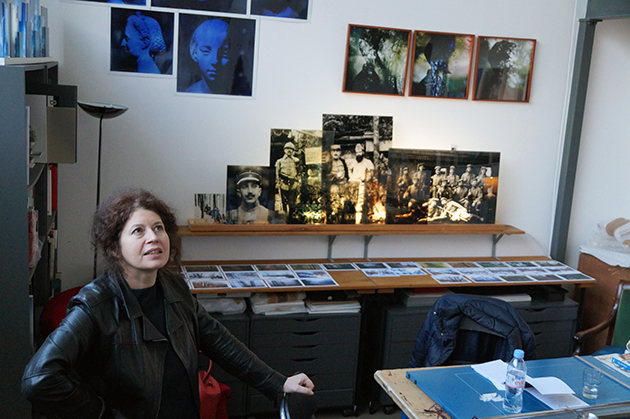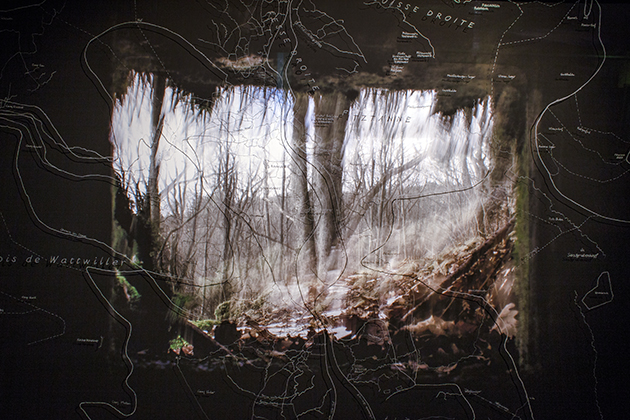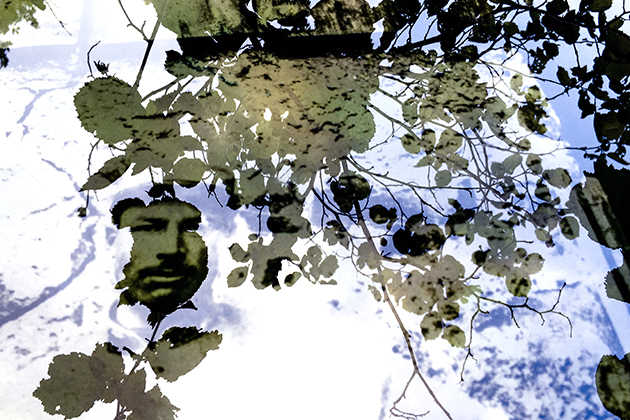An artist’s view: Sophie Zénon

Photographer and visual artist Sophie Zénon looks at the question of restoring the memory of Hartmannswillerkopf (HWK), the scene of fighting in the First World War, whose peculiarity is that its front line lay along the Franco-German border. In 2017, she became artist in residence at the Abri-Mémoire in Uffholtz, an educational space for the public where she undertook a creative project and gave a workshop.

Sophie Zénon © www.sophiezenon.com
Why did you choose to work on Hartmannswillerkopf?
My father was brought up in the Vosges. He often talked of the “magic” of the great Vosges forests, which I discovered in 2015, when I began working on the history of our family from its origins in Italy. More specifically, my interest in HWK arose from an invitation from the Abri-Mémoire in Uffholtz. In 2013, I had produced an artist’s book entitled Verdun, ses ruines glorieuses (Verdun’s glorious ruins), in which I looked at the theme of Franco-German reconciliation. When I showed them this book, they were definite about my coming to the Vosges to pursue the project.
What did your work on the site consist of?
I proposed to the Abri-Mémoire an interpretation of HWK from the perspective of its restored forest, in which I sought to take account of both the ‘spirit of the place’ and the way in which people past and present have learnt to live alongside this forest. What is it like today for the people of the surrounding communes to live near a place so steeped in tragedy? And how did the soldiers of the First World War survive this hell? Hence my title, ‘Pour Vivre Ici’ (To Live Here).
To gain an understanding of how the forest has evolved, I began by interviewing staff of the National Forestry Office (ONF). Before 1914, it was a large pine forest. By 1918, the landscape was ravaged. Then, in the 1930s, the forest began to grow back, without human intervention, consisting mainly of broadleaves. This transformation fascinated me. I became interested in the landscape in different seasons, and I walked the length and breadth of HWK, making a series of tree portraits which I printed in large format, protected by sheets of glass that I engraved with military maps.

Lippische Schweiz (Pour Vivre Ici) [Lippische Schweiz (To Live Here)]. Fine art print and glass engraving, 80 x 120 cm. Unique piece. © S. Zénon
I went on to research place names. The names given to the mountain by the French and German soldiers reveal a collective imagination which I recreated in the form of an immense panoramic wallpaper, consisting of postcards dating from before and during the First World War. The idea of this project was also to borrow from regional skills and introduce them into my own work (Rixheim wallpaper-making and Alsatian and Lorraine glassmaking).
From the Abri-Mémoire resource centre archives, I selected photos of French and German soldiers in their day-to-day lives, which I printed on sheets of perspex and installed in the forest. The play of the sun’s rays makes the faces appear and disappear in a sort of dazzle.
My meeting with Raoul Ermel, a joiner from Wattwiller, was crucial. His approach to the forest introduced me to an almost supernatural world. His paternal grandfather, a nature-lover and HWK veteran, brought him to the mountains from an early age. He knows every inch of the forest. For him, the trees are custodians of the soldiers’ memory. From the physiognomy of their trunks, he can tell which lived through the war (“which could speak”), and which “in all likelihood are not tormented for nothing”.
Finally, I selected extracts from the junior officer Henri Martin’s diary, Le Vieil Armand, 1915 (Payot, 1937), which I chose for their literary qualities and their profound humanity. I made a 17-minute video, in which Raoul and Martin’s voices intermingle with archives, photographs and video footage of trees.

Après un Rêve (Pour Vivre Ici) [After a Dream (To Live Here)]. Fine art print, 45 x 30 cm. Detail from a polyptych of 15 photographs. © S. Zénon
As artist in residence at the Abri-Mémoire, you gave an educational workshop. What did that consist of?
Alexandre Dumez, a history teacher at Wittelsheim high school and educational adviser to the HWK history museum, invited me to take a workshop with his class of première students (16 and 17 year-olds). I asked the students to think about the concepts of borders and identity, and to work on narration. They began by making in situ portraits in pairs. I put together learning materials, slide shows on photographers who have photographed the battlefields or who explore the relationship between image and text, like the Chinese artist Gao Bo, who, in his work on Tibet, writes on his photographs in his own blood to denounce the massacre of the Tibetans.
For this workshop, the students took my perspexes of soldiers and laid them out in the landscape. The 24 students were split into three groups: the first on the summit (the scene of the most intense fighting), the second near the river, and the third in a German trench, in order to have three landscapes and three different perspectives. I asked them to write a short text about how they felt. The workshop lasted a week, on site and in class. The most time-consuming part was making the compositions, mostly triptychs, with texts in French and German, which combined to form a large polyptych.
What struck the students the most was how young the soldiers were. They realised that it could have been them. The works were presented at the official opening of the HWK Museum of Franco-German History, attended by the French and German presidents, on 10 November 2017. A moment of intense emotion that the students will not forget.
Pour Vivre Ici is showing at Beauvais until December 2018, as part of the Les Photaumnales festival. A book will be brought out in November by Editions Loco.
The editorial team

